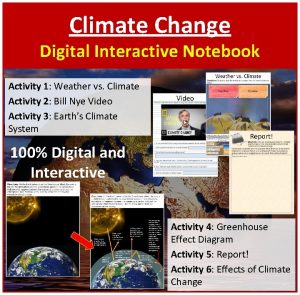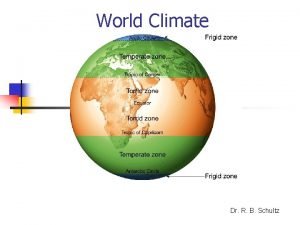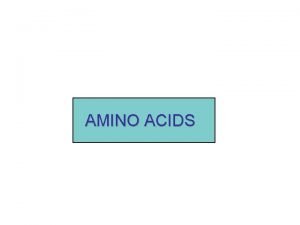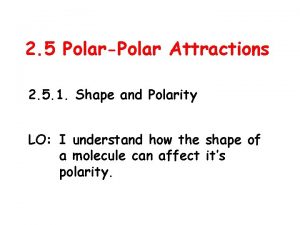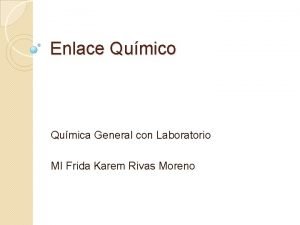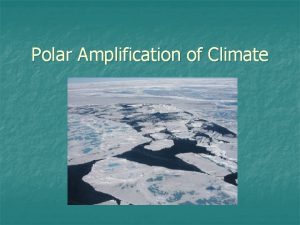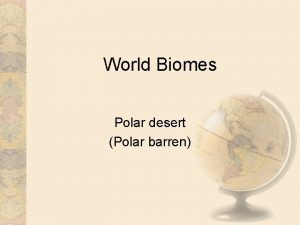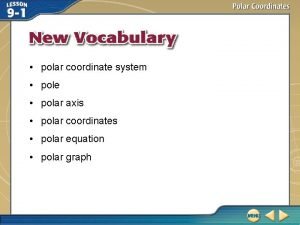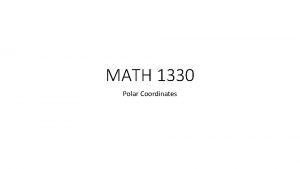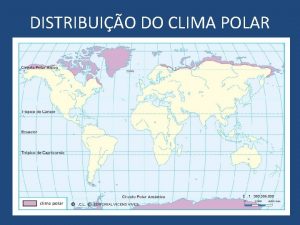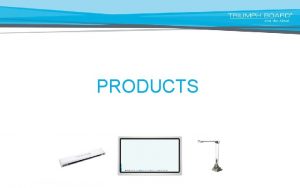POLAR I C E Interactive Climate Education WHAT

















- Slides: 17

POLAR I. C. E. (Interactive Climate Education) WHAT IS HAPPENING TO ANTARCTICA’S PINE ISLAND GLACIER? P. I. G. ice shelf, photo M. Wolovick http: /www. ldeo. columbia. edu/polareducation

ABOUT GLACIERS… Glaciers are large expanses of ice. In the polar regions they are continental sized! Greenland’s Kangerdlugssuaq Glacier, photo by P. Spector • Glaciers form where snow remains year-round, compressing into ice over time. • Glacier Accounting is like a bank account: 1. They remain balanced (equal in size) if the snow added annually equals the snow lost; 2. They grow when more is added (snow) than removed (melt); 3. They shrink when more is removed (melts) than added (snow).

Glaciers are in constant motion. Tugged by gravity they move under their own weight, flowing from areas of higher elevation to areas of lower elevation. Greenland’s Kangerdlugssuaq Glacier, photo by P. Spector

Calving – One way in which glaciers lose mass Steep edge where sections of ice break off at the front of a glacier, collapsing into icy rubble. Glaciers in the polar regions can lose ‘mass’ in several ways – calving (chunks of ice breaking off ), melting, wind blow, and sublimating straight to water vapor. This loss of ice mass is called ‘ablation’. Greenland’s Jakobshavn Glacier, photo by I. Das

The Glacial System Start with ‘New snow falls’ and move counter clockwise to follow the system. ‘Accumulation’ ‘Ablation’ edited from R. Bell, The Unquiet Ice, Scientific American, Feb. ‘ 08)

About Measuring Glaciers… • Satellites have been collecting information about the Earth since the 1990’s. • NASA ICESat I used a laser to measure ice surface elevation from 2003 to 2009. These measurements are accurate to ~15 cm (6 inches) of elevation! • Today’s activity uses ICESat data to measure changes to ice elevation of Pine Island Glacier.

About Pine Island Glacier (P. I. G. )… Glac i flow er dire ction This activity focuses on ice surface elevation on P. I. G. The red line shows where the ICESat ice surface data used in this activity was collected.

Where in Antarctica is Pine Island Glacier? Edited Antarctic land surface map (without ice) from British Antarctic Survey BEDMAP program, 2011.

About Antarctica’s Ice Shelves… Ea An We ta st rc tic a • • An st ta rc tic a Ice Shelves surround the Antarctic Ice Sheet. Like barricades they block the glaciers, slowing the ice flow off the landmass. The larger the ice shelf, the larger the barricade. Pine Island Glacier has a very small ice shelf – too small to show in this graphic. Edited from T. Scambos, National Snow and Ice Data Center

Is P. I. G. a ‘climate canary’*? Let’s do the activity! Working with Ice Elevation Data from P. I. G. you can answer this important question! *Years ago miners used canaries as an early warning signal to alert them to toxic changes in the air inside the mines. Canaries have become a symbol of an early alert to approaching danger. Our canary wears shades as protection from the reflectivity of the glacial snow (known as albedo). Ice albedo is a key ingredient in the ongoing cooling of our Earth system.

GRAPHING P. I. G. DATA FOR LINE #279 LOCATION ELEVATIO DELTA RECORDED IN METERS N N NOV. 2003 BY KM NOV. 2003 IN METERS TO TO APR. 2007 OCT. 2007 APRIL 2007 OCT. 2007 0 0 239 746 746 -1 -1 240 512 511 -3 -5 241 392 389 387 -8 -9 242 343 335 334 -12 -15 243 279 267 264 -16 -18 244 245 229 227 -12 -19 245 293 281 274 -16 -20 246 332 316 312 -15 -17 247 389 374 372 -12 -5 248 480 468 475 -7 -10 249 507 500 497 -12 250 557 545 -4 -4 251 573 569 -4 -4 252 604 600 -3 -3 253 690 687

Complete Part I… the first graphing activity.

Graph of 3 sets of P. I. G. elevation data 800 700 Meters of elevation 600 500 Nov. 2003 400 Apr. 2007 Oct. 2007 300 200 100 0 239 240 241 242 243 244 245 246 247 248 Distance in kilometers 249 250 251 252 253

GRAPHING P. I. G. DATA FOR LINE #279 LOCATION ELEVATION RECORDED IN METERS BY KM NOV. 2003 239 240 241 242 243 244 245 246 247 248 249 250 251 252 253 746 512 392 343 279 245 293 332 389 480 507 557 573 604 690 ELEVATION IN METERS APR. 2007 746 511 389 335 267 229 281 316 374 468 500 545 569 600 687 ELEVATIO DELTA N IN METERS NOV. 2003 TO OCT. 2007 APRIL 2007 OCT. 2007 0 0 746 -1 -1 511 -3 387 334 -15 264 -16 -18 227 -12 274 -16 312 -17 372 -12 475 -7 -10 497 -12 545 -4 569 -4 600 -3 -3 687 For each dataset in 2007 you will calculate the change (delta ) from 2003, completing the last two columns in this chart. Then graph the in Part II, using 2003 as your zero line and the for April and October 2007.

Complete Part II…. the second graphing activity.

Graph of delta-comparison to 2003 Delta in elevation ( Meters) 5 Distance in kilometers (from baseline Nov 0 239 240 241 242 243 244 245 246 -5 -10 April 2007 -15 -20 -25 Oct. 2007 248 249 250 251 252 253

Project website: http: //www. ldeo. columbia. edu/icepod/ Education website: http: //www. ldeo. columbia. edu/polareducation/
 Weather and climate interactive activities
Weather and climate interactive activities Climate change 2014 mitigation of climate change
Climate change 2014 mitigation of climate change Which two types of polar climate are recognized?
Which two types of polar climate are recognized? Covalent bond
Covalent bond 10 ejemplos fuerzas de van der waals ejemplos
10 ejemplos fuerzas de van der waals ejemplos Essential amino acids arginine
Essential amino acids arginine Polar attractions are
Polar attractions are Polar and non polar dielectrics
Polar and non polar dielectrics Fqcolindres 2 eso
Fqcolindres 2 eso Interactive patient education systems
Interactive patient education systems Gcche
Gcche Financing education in a climate of change
Financing education in a climate of change Creating a climate hospitable to education
Creating a climate hospitable to education Difference between als and formal education
Difference between als and formal education Differentiate between health education and health promotion
Differentiate between health education and health promotion Types of extension education
Types of extension education Mussolini death
Mussolini death Multimedia becomes interactive multimedia when
Multimedia becomes interactive multimedia when
